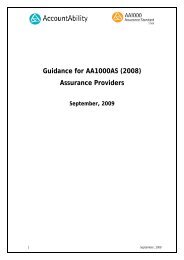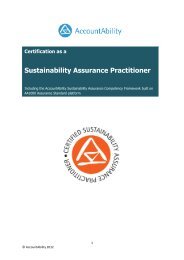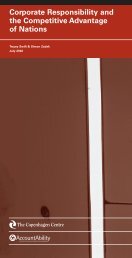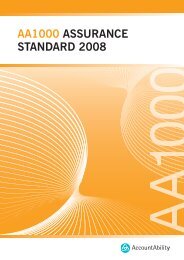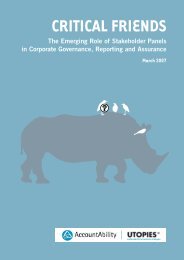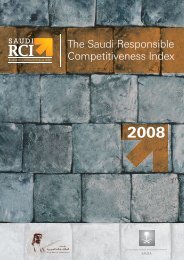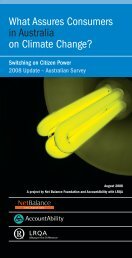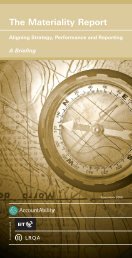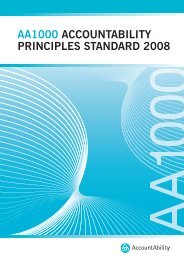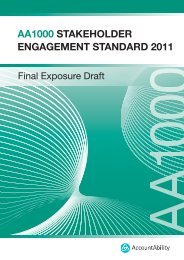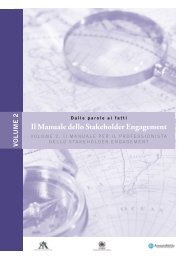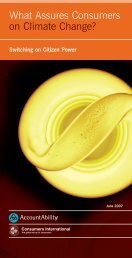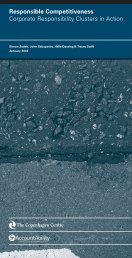The Stakeholder Engagement Manual Volume 2 - AccountAbility
The Stakeholder Engagement Manual Volume 2 - AccountAbility
The Stakeholder Engagement Manual Volume 2 - AccountAbility
Create successful ePaper yourself
Turn your PDF publications into a flip-book with our unique Google optimized e-Paper software.
Take action and review the engagement<br />
P17: REPORTING BACK AND GIVING ASSURANCE TO YOUR STAKEHOLDERS<br />
Checklist for Reporting to <strong>Stakeholder</strong>s<br />
AA1000AS Principle<br />
Materiality …refl ect how the organisation defi nes which stakeholder issues are material to its<br />
business?<br />
…discuss what criteria are used in making decisions about materiality?<br />
…explain why the identifi ed stakeholders/issues are either material or not?<br />
…refl ect how dilemmas between different expectations regarding materiality are<br />
acknowledged?<br />
…discuss whether indicators and targets included in the report can be, and are, used in<br />
strategic and operational decision-making processes?<br />
Completeness …indicate how the organisation seeks to understand its performance and impacts<br />
relating to material issues (e.g. why it uses specifi c indicators, management and<br />
internal assurance processes etc)?<br />
…indicate how the organisation has decided on what performance aspects to include in<br />
its measurement (e.g. activities, products, sites and subsidiaries)?<br />
…indicate how the organisation integrates these measures with its core management,<br />
governance and change processes?<br />
…enable stakeholders to interpret the information in ways that is useful for their<br />
decision-making (e.g. ensuring accuracy of information)?<br />
Responsiveness<br />
Does the internal and / or external report. . .<br />
…discuss the reasoning used by the organisation in deciding what issues to respond to?<br />
…refl ect how the organisation allocates resources to enable the implementation of<br />
commitments to respond to material stakeholder issue?<br />
Do these resources appear adequate?<br />
…discuss how the organisation identifi es any shortfalls and subsequent corrective actions<br />
in relation to material issues?<br />
…specify targets relating to identifi ed improvement needs? What is the technical quality<br />
of these targets (i.e. are targets timely, measurable, specifi c, realistic etc.)?<br />
Finally, a report can also be a powerful tool for assuring your stakeholders.<br />
A high-quality report which meets many of the above criteria can assure<br />
stakeholders of the quality of your response to their concerns and expectations.<br />
However, more formal assurance of the process of stakeholder engagement, and<br />
of the resulting report, can enhance your credibility and build further trust.<br />
What is Assurance?<br />
Assurance is an evaluation method that uses a specifi ed set of principles and standards<br />
to assess the quality of a subject, such as an organisation’s internal and/or external report<br />
or stakeholder engagement activities, as well as the underlying systems, processes and<br />
competencies that underpin the organisation’s performance. Assurance includes the<br />
communication of the results of this assessment to provide credibility to the subject matter<br />
for its users.<br />
Assurance is not to be confused with audit, verifi cation or certifi cation. Assurance is the<br />
desired result. Audit, verifi cation and certifi cation are examples of tools to achieve such<br />
results, in addition to historical experiences, reputation, or indeed engagement itself.<br />
Source: <strong>AccountAbility</strong> 2005



